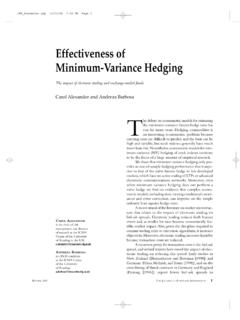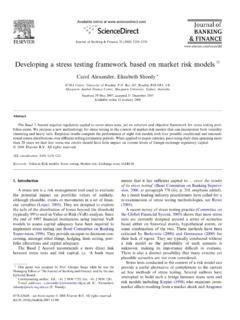Transcription of Optimal Hedging Using Cointegration - Carol …
1 R THE ROYAL. igI SOCIETY. Optimal Hedging Using Cointegration BY C. ALEXANDERt School of Mathematics and Statistics, University of Sussex, Falmer BN1 9QH, UK. Cointegration is a time-series modelling methodology that has many applications to financial markets. When spreads are mean reverting, prices are cointegrated. Then a multivariate model will provide further insight into the price equilibria and returns causalities within the system. Spot-futures arbitrage, yield curve modelling, index tracking and spread trading are some of the applications of Cointegration that are reviewed in this paper.
2 With the demand for new quantitative approaches to active investment management strategies there is considerable interest in Cointegration the- ory. This paper presents a model of cointegrated international equity portfolios which is currently used for Hedging within the European, Asian and Far East countries. Keywords: Cointegration ; Hedging ; index tracking; financial markets 1. Introduction Since the seminal work of Engle & Granger (1987), Cointegration has become the prevalent tool of time-series econometrics. Every modern econometrics text covers the statistical theory necessary to master the practical application of Cointegration , Campbell et al.
3 (1997), Hamilton (1994) and Hendry (1995, 1986) being amongst the best sources. Cointegration has emerged as a powerful technique for investigating common trends in multivariate time-series, and provides a sound methodology for modelling both long-run and short-run dynamics in a system. Although models of cointegrated financial time-series are now relatively common- place in the literature, their importance has, until very recently, been mainly theo- retical. This is because the traditional starting point for portfolio risk management in practice is a correlation analysis of returns, whereas Cointegration is based on the raw price, rate or yield data.
4 In standard risk-return models these price data are differenced before the analysis is even begun, and differencing removes a priori any long-term trends in the data. Of course, these trends are implicit in the returns data, but any decision based on long-term common trends in the price data is excluded in standard risk-return modelling. Cointegration and correlation are related, but different concepts. High correlation of returns does not necessarily imply high Cointegration in prices. An example is given in figure 1, with a 10 year daily series on US dollar spot exchange rates of the German Mark (DEM) and the Dutch Guilder (NLG) from 1982 to 1992.
5 Their returns are very highly correlated: the correlation coefficient is approximately (figure la). So also do the rates move together over long periods of time, and they appear to be cointegrated (figure lb). Now suppose that we add a very small daily incremental return of, say, to NLG. The returns on this NLG 'plus' and the t Visiting Research Fellow, OCIAM, Mathematical Institute, 24-29 St Giles', Oxford OX1 3LB, UK. Phil. Trans. R. Soc. Lond. A (1999) 357, 2039-2058 ? 1999 The Royal Society 2039. 2040 C. Alexander (a) 1--'[ DutchGuilder - DeutscheMark 11z1444+#Mf1| pi j.]
6 I. Figure 1. (a) NLG and DEM returns. (b) NLG and DEM rates. (c) NLG 'plus' versus DEM. DEM still have correlation of , but the price series diverge and they are not cointegrated (figure lc).t Correlation reflects co-movements in returns, which are liable to great instabili- ties over time. It is intrinsically a short-run measure, and correlation-based Hedging strategies commonly require frequent rebalancing. On the other hand, Cointegration t These figures have been reproduced with permission of Pennoyer Capital Management, Inc. Phil. Trans. R. Soc. Lond. A (1999). Optimal Hedging Using Cointegration 2041.
7 Measures long-run co-movements in prices, which may occur even through periods when static correlations appear low. Therefore, Hedging methodologies based on coin- tegrated financial assets may be more effective in the long term. In summary, investment management strategies that are based only on volatil- ity and correlation of returns cannot guarantee long-term performance. There is no mechanism to ensure the reversion of the hedge to the underlying, and nothing to pre- vent the tracking error from behaving in the unpredictable manner of a random walk. Since high correlation alone is not sufficient to ensure the long-term performance of hedges, there is a need to augment standard risk-return modelling methodologies to take account of common long-term trends in prices.
8 This is exactly what cointegra- tion provides. It extends the traditional models to include a preliminary stage in which the multivariate price data are analysed, and then augments the correlation analysis to include the dynamics and causal flows between returns. This paper begins with a short survey of the theory and application of cointegra- tion to pricing, Hedging and trading portfolios of financial assets. Section 2 covers the basic mathematics necessary to understand the main concepts and ? 3 reviews some of the literature on Cointegration in finance. We emphasize the implications of coin- tegration for Hedging strategies and draw attention to areas where mis-pricing and over- Hedging can occur if Cointegration is ignored.
9 Examples of cointegrated finan- cial assets abound: spot and futures; bonds of different maturities, or even between countries, in fact anywhere where spreads are mean reverting; related commodities (when carry costs are well behaved); and equities within an index, or between inter- national indices. It is this last example that is studied in detail. Asset managers are developing increasingly quantitative approaches and with the need for new, active management strategies there is considerable interest in Cointegration at present. Sec- tion 4 presents one such model of cointegrated international equity portfolios that has been developed and extended over several years and is currently used for Hedging within the EAFE countries.
10 2. The mathematics of Cointegration (a) Basic notation and terminology The term 'mean reversion' in finance is used to describe what in statistical terms is called a 'covariance stationary' time-series, denoted I(0). This is a stochastic process with constant finite mean and variance, and an autocorrelation that is independent of time (depending only on the lag). Typically, financial returns are (covariance). stationary processes. A series which is non-stationary, and only stationary after differencing a minimum of n times, is called 'integrated of order n', denoted I(n). An example of an integrated series of order 1 is a random walk Yt = a+ Yt-i + t, where a denotes the drift, and the error process Et is an independent and identically distributed ( ) stationary process.





